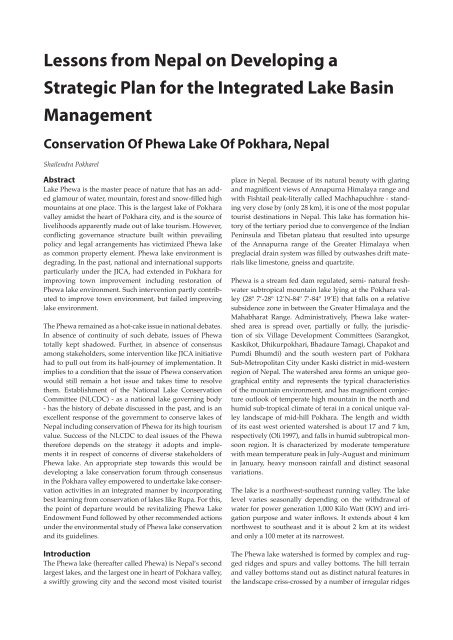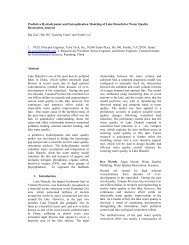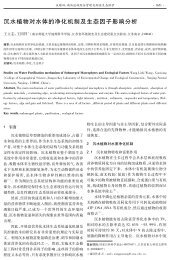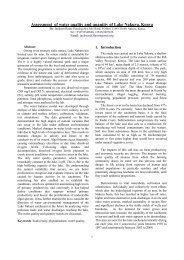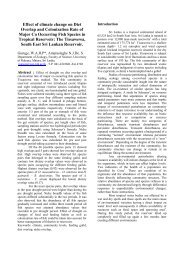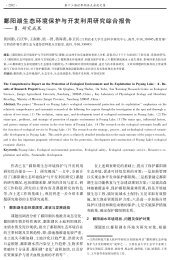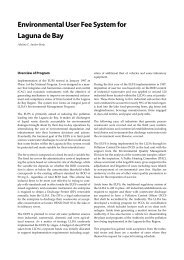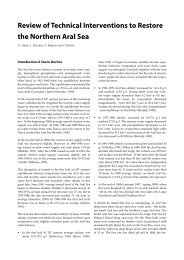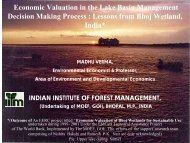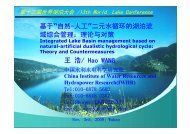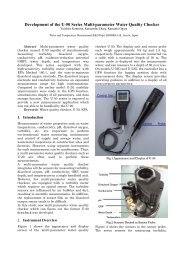Lessons from Nepal on Developing a Strategic Plan - World Lake ...
Lessons from Nepal on Developing a Strategic Plan - World Lake ...
Lessons from Nepal on Developing a Strategic Plan - World Lake ...
- No tags were found...
You also want an ePaper? Increase the reach of your titles
YUMPU automatically turns print PDFs into web optimized ePapers that Google loves.
<str<strong>on</strong>g>Less<strong>on</strong>s</str<strong>on</strong>g> <str<strong>on</strong>g>from</str<strong>on</strong>g> <str<strong>on</strong>g>Nepal</str<strong>on</strong>g> <strong>on</strong> <strong>Developing</strong> a<strong>Strategic</strong> <strong>Plan</strong> for the Integrated <strong>Lake</strong> BasinManagementC<strong>on</strong>servati<strong>on</strong> Of Phewa <strong>Lake</strong> Of Pokhara, <str<strong>on</strong>g>Nepal</str<strong>on</strong>g>Shailendra PokharelAbstract<strong>Lake</strong> Phewa is the master peace of nature that has an addedglamour of water, mountain, forest and snow-filled highmountains at <strong>on</strong>e place. This is the largest lake of Pokharavalley amidst the heart of Pokhara city, and is the source oflivelihoods apparently made out of lake tourism. However,c<strong>on</strong>flicting governance structure built within prevailingpolicy and legal arrangements has victimized Phewa lakeas comm<strong>on</strong> property element. Phewa lake envir<strong>on</strong>ment isdegrading. In the past, nati<strong>on</strong>al and internati<strong>on</strong>al supportsparticularly under the JICA, had extended in Pokhara forimproving town improvement including restorati<strong>on</strong> ofPhewa lake envir<strong>on</strong>ment. Such interventi<strong>on</strong> partly c<strong>on</strong>tributedto improve town envir<strong>on</strong>ment, but failed improvinglake envir<strong>on</strong>ment.The Phewa remained as a hot-cake issue in nati<strong>on</strong>al debates.In absence of c<strong>on</strong>tinuity of such debate, issues of Phewatotally kept shadowed. Further, in absence of c<strong>on</strong>sensusam<strong>on</strong>g stakeholders, some interventi<strong>on</strong> like JICA initiativehad to pull out <str<strong>on</strong>g>from</str<strong>on</strong>g> its half-journey of implementati<strong>on</strong>. Itimplies to a c<strong>on</strong>diti<strong>on</strong> that the issue of Phewa c<strong>on</strong>servati<strong>on</strong>would still remain a hot issue and takes time to resolvethem. Establishment of the Nati<strong>on</strong>al <strong>Lake</strong> C<strong>on</strong>servati<strong>on</strong>Committee (NLCDC) - as a nati<strong>on</strong>al lake governing body- has the history of debate discussed in the past, and is anexcellent resp<strong>on</strong>se of the government to c<strong>on</strong>serve lakes of<str<strong>on</strong>g>Nepal</str<strong>on</strong>g> including c<strong>on</strong>servati<strong>on</strong> of Phewa for its high tourismvalue. Success of the NLCDC to deal issues of the Phewatherefore depends <strong>on</strong> the strategy it adopts and implementsit in respect of c<strong>on</strong>cerns of diverse stakeholders ofPhewa lake. An appropriate step towards this would bedeveloping a lake c<strong>on</strong>servati<strong>on</strong> forum through c<strong>on</strong>sensusin the Pokhara valley empowered to undertake lake c<strong>on</strong>servati<strong>on</strong>activities in an integrated manner by incorporatingbest learning <str<strong>on</strong>g>from</str<strong>on</strong>g> c<strong>on</strong>servati<strong>on</strong> of lakes like Rupa. For this,the point of departure would be revitalizing Phewa <strong>Lake</strong>Endowment Fund followed by other recommended acti<strong>on</strong>sunder the envir<strong>on</strong>mental study of Phewa lake c<strong>on</strong>servati<strong>on</strong>and its guidelines.Introducti<strong>on</strong>The Phewa lake (hereafter called Phewa) is <str<strong>on</strong>g>Nepal</str<strong>on</strong>g>’s sec<strong>on</strong>dlargest lakes, and the largest <strong>on</strong>e in heart of Pokhara valley,a swiftly growing city and the sec<strong>on</strong>d most visited touristplace in <str<strong>on</strong>g>Nepal</str<strong>on</strong>g>. Because of its natural beauty with glaringand magnificent views of Annapurna Himalaya range andwith Fishtail peak-literally called Machhapuchhre - standingvery close by (<strong>on</strong>ly 28 km), it is <strong>on</strong>e of the most populartourist destinati<strong>on</strong>s in <str<strong>on</strong>g>Nepal</str<strong>on</strong>g>. This lake has formati<strong>on</strong> historyof the tertiary period due to c<strong>on</strong>vergence of the IndianPeninsula and Tibetan plateau that resulted into upsurgeof the Annapurna range of the Greater Himalaya whenpreglacial drain system was filled by outwashes drift materialslike limest<strong>on</strong>e, gneiss and quartzite.Phewa is a stream fed dam regulated, semi- natural freshwatersubtropical mountain lake lying at the Pokhara valley(28º 7’-28º 12’N-84º 7’-84º 19’E) that falls <strong>on</strong> a relativesubsidence z<strong>on</strong>e in between the Greater Himalaya and theMahabharat Range. Administratively, Phewa lake watershedarea is spread over, partially or fully, the jurisdicti<strong>on</strong>of six Village Development Committees (Sarangkot,Kaskikot, Dhikurpokhari, Bhadaure Tamagi, Chapakot andPumdi Bhumdi) and the south western part of PokharaSub-Metropolitan City under Kaski district in mid-westernregi<strong>on</strong> of <str<strong>on</strong>g>Nepal</str<strong>on</strong>g>. The watershed area forms an unique geographicalentity and represents the typical characteristicsof the mountain envir<strong>on</strong>ment, and has magnificent c<strong>on</strong>jectureoutlook of temperate high mountain in the north andhumid sub-tropical climate of terai in a c<strong>on</strong>ical unique valleylandscape of mid-hill Pokhara. The length and widthof its east west oriented watershed is about 17 and 7 km,respectively (Oli 1997), and falls in humid subtropical m<strong>on</strong>so<strong>on</strong>regi<strong>on</strong>. It is characterized by moderate temperaturewith mean temperature peak in July-August and minimumin January, heavy m<strong>on</strong>so<strong>on</strong> rainfall and distinct seas<strong>on</strong>alvariati<strong>on</strong>s.The lake is a northwest-southeast running valley. The lakelevel varies seas<strong>on</strong>ally depending <strong>on</strong> the withdrawal ofwater for power generati<strong>on</strong> 1,000 Kilo Watt (KW) and irrigati<strong>on</strong>purpose and water inflows. It extends about 4 kmnorthwest to southeast and it is about 2 km at its widestand <strong>on</strong>ly a 100 meter at its narrowest.The Phewa lake watershed is formed by complex and ruggedridges and spurs and valley bottoms. The hill terrainand valley bottoms stand out as distinct natural features inthe landscape criss-crossed by a number of irregular ridges
emerge <strong>on</strong> lakes around the world (Borre et al., 2001). Inthis c<strong>on</strong>text, major envir<strong>on</strong>mental threats of <strong>Lake</strong> Phewaof <str<strong>on</strong>g>Nepal</str<strong>on</strong>g>, a least developed country, indicated as followsindicate some similarity and differences:C<strong>on</strong>flicting Legal Issues: By nature, lakes are interfacesof land, water and forests that represent complex ecosystem,but management of these lakes in <str<strong>on</strong>g>Nepal</str<strong>on</strong>g> remainsseriously divided as it falls within the jurisdicti<strong>on</strong> of differentgovernment authorities. <strong>Lake</strong> subject is narrowlyorganized al<strong>on</strong>g defined sectoral lines under existinglegal provisi<strong>on</strong>s like Aquatic Animal Protecti<strong>on</strong> Act 1961(amended first in1999); Forest Act 1993 (amended in 2001);Nati<strong>on</strong>al Park and Wildlife C<strong>on</strong>servati<strong>on</strong> Act; Forest Act1993 (amended in 2001); Soil and Watershed C<strong>on</strong>servati<strong>on</strong>Act 1982; Water Resources Act 1992; Electricity Act 1992;Envir<strong>on</strong>ment Protecti<strong>on</strong> Act 1996. Further, Local SelfGovernance Act (1999) empowers local governmentlike District Development Committees (DDCs), VillageDevelopment Committees (VDCs), Municipal Authorities,and Metropolitan Authorities towards c<strong>on</strong>servati<strong>on</strong> andsustainable development. Under this Act, promoting socioec<strong>on</strong>omicdevelopment, natural resources managementand c<strong>on</strong>servati<strong>on</strong> become sole resp<strong>on</strong>sibility of these localbodies at their levels (Oli 1997).Municipality Act (1991) empowers Pokhara Sub-Metropolyfor managing garbage collecti<strong>on</strong> and disposal, and polluti<strong>on</strong>c<strong>on</strong>trol <str<strong>on</strong>g>from</str<strong>on</strong>g> the lake shore, and building norms, rules,regulati<strong>on</strong>s and taking punitive acti<strong>on</strong>s against defaulters.Town Development Act (1988) empowers the TownDevelopment Committee to enforce land use and buildingregulati<strong>on</strong>s, and implements physical developmentplans and programs, and also has the authority to takepunitive acti<strong>on</strong> against those who ignore the regulati<strong>on</strong>s,and violate the norms and standards set by the committee.Since six VDCs apart <str<strong>on</strong>g>from</str<strong>on</strong>g> the Pokhara Municipalitytouches the boundary of the lake, Phewa lake is subjectedto the Committees authority derived <str<strong>on</strong>g>from</str<strong>on</strong>g> Act of 1991.Since DDC is the main coordinating agency for all VDCsin the district, Kaski DDC also has authority over Phewalake deriving <str<strong>on</strong>g>from</str<strong>on</strong>g> the Act of 1991. Phewa watershed issubjected to the Forest Act, Soil and Water C<strong>on</strong>servati<strong>on</strong>Act, Water Resources Act, and both the DDDC/VDC Acts,Municipality Act, Town Development Act, Aquatic LifeAct, 1961, thus each agency operating under their ownlegal mandate and do caring a little of others. This situati<strong>on</strong>is c<strong>on</strong>tinuous and is <strong>on</strong>e of the major causes for envir<strong>on</strong>mentaln<strong>on</strong>compliance and poor legal enforcement in thewatershed. This has resulted in the development of unc<strong>on</strong>trolledurbanizati<strong>on</strong> and inc<strong>on</strong>sistent land use in the Phewalakeshore area resulting it as ‘a tragedy of comm<strong>on</strong>s’.Reclamati<strong>on</strong> & Encroachment: With an extent of growingurbanizati<strong>on</strong> multiplied with undefined and officially n<strong>on</strong>demarcatedshoreline, there has been a significant reducti<strong>on</strong>in lake morphometry. Within a short period of 1981-2001,5.8 km 2 of lake area of 1981 now has been reduced to 4.4km 2 by 2001. Such illustrati<strong>on</strong> is seen distinct in lake-head,<strong>on</strong>ce completely submerged now surfaced as alluvial plain,due to heavy sediment load carried by Harpan Khola.Initially, such areas were illegally encroached for agricultureand settlements subsequently legalized by cadastralsurvey of 1975. Further, roads and poorly c<strong>on</strong>structed smallhouses al<strong>on</strong>g shoreline east of dam in Baidam are intense,and areas al<strong>on</strong>g Phirke Khola that also drains water in thelake, has been extensively used for building c<strong>on</strong>structi<strong>on</strong>including government buildings, such as Municipal GuestHouse, Armed Police Office and their Quarters, as well assquatter settlements.In the past, certain efforts to define shoreline were madethat prescribed sets of government standards to regulateurban development al<strong>on</strong>g shoreline, but a physical collapseof Phewa dam occurred in 1974 that drained outmuch of lake water causing lake area shrinking to a smallerarea. Such collapse exposed out the land due to recedingof shoreline, later illegally encroached by adjoining landowners.This problem was further cropped up after theadvent of Democracy Movement-1989. Already set government’snorms were either not respected or neglected thatsubsequently resulted into irregular and uneven erecti<strong>on</strong>of numerous sub-standard buildings and hotels al<strong>on</strong>glake shoreline particularly in the southwestern part of lake(except Raniban), in Anadu and the area to Simle and evenbey<strong>on</strong>d. Adverse impacts of such phenomen<strong>on</strong> has beenC<strong>on</strong>servati<strong>on</strong> Of Phewa <strong>Lake</strong> Of Pokhara, <str<strong>on</strong>g>Nepal</str<strong>on</strong>g>3
noticed <strong>on</strong> shortage of drinking water, roads, drainagesystem, depleti<strong>on</strong> of wildlife habitats, spoilt amenities aswell as trickled down tourism around Phewa by noise andwater polluti<strong>on</strong>, narrow trails and pathways and sewagedisposals. Unsightliness has also been augmented.Sedimentati<strong>on</strong>: Physical shape and size of Phewa is degradingbecause of sedimentati<strong>on</strong> and land encroachment al<strong>on</strong>glakeshore. Sediment comprising silt, sand and gravel aretransported in the lake by Harpan Khola, and sediments inthe form of urban garbage are also being transported in thelake by Seti Canal, Bulanudi and Phirke Khola. Seti Canal,Bulaundi and Phirke Khola also transport silt and sand insmall quantities whose annual cumulative effect is huge.It is estimated that during the period of 1990-’94, annualsiltati<strong>on</strong> rte has a range of about 175,000-225,000 m 3 . At thisrate the terminal silt trap porti<strong>on</strong> will be separated <str<strong>on</strong>g>from</str<strong>on</strong>g> themain lake by next 20-25 years and the lake proper will be“dead” by next 135-175 years, assuming loss of 80% watervolume (DSC, 1994). A time series map analysis indicate adecrease in area <str<strong>on</strong>g>from</str<strong>on</strong>g> 10 km 2 (1956/57), to 5.5 km 2 (‘76) and4.4 km 2 (‘98). There has been more than 50% reducti<strong>on</strong> inarea within a time frame of 5 decades (JICA/SILT, 2002).<strong>Lake</strong> Phewa is polluted due to high internal loading ofsediments (SAIC, 1992).<strong>Lake</strong> Water Polluti<strong>on</strong>: Despite having picturesque outlook,Phewa has been experiencing marked changes in itsenvir<strong>on</strong>mental quality over the past years, due to extremewater polluti<strong>on</strong> caused by sewerage, solid wastes, clotheswashing, agricultural run-off and sediments. Table 2 brieflypresents the physical and chemical features of Phewa lake.Cultural eutrophicati<strong>on</strong> is c<strong>on</strong>sidered major parameter forwater quality management in Phewa. Since managementinterventi<strong>on</strong> against polluti<strong>on</strong> c<strong>on</strong>trol are not in effect,density of E-colii (39-123 units/100 ml), regular disposal ofsolid waste (125 mt) and of soaps and detergents (> 100 kg)per day seems c<strong>on</strong>tinue to cultivate in lake.Threats to Biodiversity: Phewa is well recognized as animperative wetlands habitat of nati<strong>on</strong>ally and internati<strong>on</strong>allysignificant aquatic biodiversity. Peripheral areas of thislake in Rani Ban and Pumdi Bhumdi forests areas are giftsfor bird lovers and researchers. The Panchase hill representsbiodiversity hotspots of wildlife and rare plants of midmountainregi<strong>on</strong> of <str<strong>on</strong>g>Nepal</str<strong>on</strong>g>. However, existing threats posedby human activities and invaders such as water hyacinth,and exotic carp fish species have caused loss of aquaticbiodiversity especially of wild rice and native fish species.It indicates laxity in management such as c<strong>on</strong>trol throughutilizati<strong>on</strong> of invasive species, and this in turn poses anadverse impact <strong>on</strong> the ecosystem health of the lake.Promoti<strong>on</strong> of Ecotourism: <strong>Lake</strong> Phewa envir<strong>on</strong>, famed as<strong>on</strong>e of the most beautiful place <strong>on</strong> earth is touristically significant.It represents a hotspot for ecotourism promoti<strong>on</strong>.However, development of tourism has been unplannedand sp<strong>on</strong>taneous. Growing urbanizati<strong>on</strong> and unplannedtourism development activities around the lake in absenceof inadequate infrastructural facilities have depressinglyaffected the lake’s recreati<strong>on</strong>al values (Banskota andSharma, 1998).Eco-z<strong>on</strong>ing of <strong>Lake</strong> Shoreline: The effects of n<strong>on</strong>-pointsources such as agricultural run off are found to be greaterthan those of point sources of polluti<strong>on</strong> such as laundryareas in <strong>Lake</strong> Phewa (Rana, 1990). As per c<strong>on</strong>servati<strong>on</strong>guideline, 10-30m strip of land al<strong>on</strong>g the lake shoreline andnext 90m is recommended for buffer z<strong>on</strong>e and c<strong>on</strong>trolleddevelopment z<strong>on</strong>e with horticultural/agro forestry activitiesrespectively (IUCN, 1995b). In practice, it needs fullimplementati<strong>on</strong>. Restructuring of the littoral z<strong>on</strong>e providesa balanced approach to lake restorati<strong>on</strong> and multiple usesof the lake, thereby integrating management practices withplanning (Engel, 1987).Inadequate Instituti<strong>on</strong>al Capability: Instituti<strong>on</strong>al inefficiencyin terms of inadequate cooperati<strong>on</strong> and coordinati<strong>on</strong>am<strong>on</strong>g stakeholders has hindered effort <strong>on</strong> sustainablemanagement of the lake resources. There is no specificauthority resp<strong>on</strong>sible for the c<strong>on</strong>servati<strong>on</strong> and managementof <strong>Lake</strong> Phewa (Banskota and Sharma, 1998) implying“tragedy of comm<strong>on</strong>s”.Table 2. Physico-chemical features of Phewa (June 2003)Parameter Unit Surface 3m 5m 10mTemperature 0°C 27.4 27.0 25.5 24.0PH 9.3 8.9 8.4 7.8Dissolve oxygen mg/lt 5.28 3.25 2.03 4.06Phenolophthalein alkalinity mg/lt A A A ATotal hardness mg/lt 77.2 88.4 77.4 77.2Free CO2 mg/lt A 1.956 1.672 0.88Chloride mg/lt 12.19 29.21 26.00 31.48Secchi disc transparency cm 177Clast size and pebblesOblate and platy4 <str<strong>on</strong>g>Less<strong>on</strong>s</str<strong>on</strong>g> <str<strong>on</strong>g>from</str<strong>on</strong>g> <str<strong>on</strong>g>Nepal</str<strong>on</strong>g> <strong>on</strong> <strong>Developing</strong> a <strong>Strategic</strong> <strong>Plan</strong> for the Integrated <strong>Lake</strong> Basin Management
Strategies And Acti<strong>on</strong>s UndertakenPolicy and Legal Provisi<strong>on</strong>sStrategies and Policies Development: In <str<strong>on</strong>g>Nepal</str<strong>on</strong>g>, governmenthas made efforts to address lake c<strong>on</strong>servati<strong>on</strong> throughpolicy integrati<strong>on</strong> in the development process. Theseinclude - the Nati<strong>on</strong>al C<strong>on</strong>servati<strong>on</strong> Strategy (NCS), 1987;the <str<strong>on</strong>g>Nepal</str<strong>on</strong>g> Envir<strong>on</strong>ment Policy and Acti<strong>on</strong> <strong>Plan</strong> (NEPAP)1993; the <str<strong>on</strong>g>Nepal</str<strong>on</strong>g> Biodiversity Strategy (NBS), 2002; andWater Resource Strategy (WRS) 2002. Under NBS, wetlandshas place as a distinct ecosystem and recommends forwetlands policy. C<strong>on</strong>sequently, Nati<strong>on</strong>al Wetlands Policyemerged out in 2003 with aims to put the c<strong>on</strong>servati<strong>on</strong> andmanagement aspects of wetlands c<strong>on</strong>servati<strong>on</strong> within theframework of broader envir<strong>on</strong>mental management. This isthe <strong>on</strong>ly <strong>on</strong>e policy arrangement resp<strong>on</strong>ding direct to wetlandsand lakes.Legal Provisi<strong>on</strong>s: No specific legal instruments thataddress lake issues are in place in <str<strong>on</strong>g>Nepal</str<strong>on</strong>g>. However, thereexist some legal instruments that protect some of the wetlandsflora and fauna across the country (inside and outsideprotected areas). Some major legal instruments arethe Nati<strong>on</strong>al Parks and Wildlife Protecti<strong>on</strong> Act (NPWPA)- 1973 (amended 4 times) for fauna, the Forest Act - 1993for flora, and the Aquatic Animals Protecti<strong>on</strong> Act - 1961 forsome specific aquatic species. Under NPWCA, 39 speciesof fauna (i.e., 27 species of mammals, 9 species of birds and3 species of reptiles) are nati<strong>on</strong>ally protected.C<strong>on</strong>servati<strong>on</strong> Acti<strong>on</strong> <strong>Plan</strong>s and Guidelines: Recognizingthe values of Phewa, many efforts have been made after1995 for its c<strong>on</strong>servati<strong>on</strong> and management. Potential causesthat degraded the Phewa lake water quality were identified.As an implementati<strong>on</strong> of the Nati<strong>on</strong>al C<strong>on</strong>servati<strong>on</strong>Strategy <strong>Plan</strong>, IUCN <str<strong>on</strong>g>Nepal</str<strong>on</strong>g> with HMGN/NPC developedGuidelines for Phewa <strong>Lake</strong> C<strong>on</strong>servati<strong>on</strong> in 1995, and alsoprepared Phewa <strong>Lake</strong> C<strong>on</strong>servati<strong>on</strong> Acti<strong>on</strong> <strong>Plan</strong> (1997).This plan has prescribed acti<strong>on</strong> areas under 10 strategicdirecti<strong>on</strong>s. They are: defining lake area and its managementresp<strong>on</strong>sibility; reviewing and preparing uniform legalframework for lake and watershed management; reviewingexisting land use plan of Pokhara (revise, amend andupdate land use strategy for the Pokhara valley); reviewingmunicipal infrastructure status and realigning Pame roadwhere necessary; c<strong>on</strong>trolling lake polluti<strong>on</strong> (developmentof an effective solid waste collecti<strong>on</strong> and disposal system);designing and executing landscaping and beautificati<strong>on</strong>schemes at strategic locati<strong>on</strong>s; formulating and executingtourism development strategy; encouraging c<strong>on</strong>servati<strong>on</strong>of biodiversity; encouraging horticulture, silviculture,aquaculture and improved animal husbandry; and encouragingwatershed management to reduce soil erosi<strong>on</strong> andsedimentati<strong>on</strong>.Pokhara Town Development <strong>Plan</strong>: For the regulatedgrowth of Pokhara, in 1973 Physical Development<strong>Plan</strong> was prepared. This was adopted by His Majesty’sC<strong>on</strong>servati<strong>on</strong> Of Phewa <strong>Lake</strong> Of Pokhara, <str<strong>on</strong>g>Nepal</str<strong>on</strong>g>Government of <str<strong>on</strong>g>Nepal</str<strong>on</strong>g>. C<strong>on</strong>sequently, Pokhara TownDevelopment Committee was established under Town <strong>Plan</strong>Implementati<strong>on</strong> Act 1972 for implementing the plan. Therehas been a significant impact after the implementati<strong>on</strong> ofdevelopment plan particularly in the c<strong>on</strong>structi<strong>on</strong> of buildings,roads and other infrastructures, however the majorissues of Phewa c<strong>on</strong>servati<strong>on</strong> still remained not addressedto this date.Instituti<strong>on</strong>sThe Nati<strong>on</strong>al <strong>Plan</strong>ning Commissi<strong>on</strong> (NPC) has been establishedto facilitate inter-sectoral coordinati<strong>on</strong> particularlyin developing nati<strong>on</strong>’s five year development plan. In suchplanning, lakes/wetlands comp<strong>on</strong>ent often emerge out as<strong>on</strong>e of the cross-sectoral priorities particularly in dem<strong>on</strong>strating<str<strong>on</strong>g>Nepal</str<strong>on</strong>g>’s commitment towards implementati<strong>on</strong> ofinternati<strong>on</strong>al c<strong>on</strong>venti<strong>on</strong>s like the CBD, Ramsar and CITES.The MoFSC is resp<strong>on</strong>sible for lake c<strong>on</strong>servati<strong>on</strong> under its4 c<strong>on</strong>stituent departments like Envir<strong>on</strong>ment Divisi<strong>on</strong>; theDNPWC; DoF; and DSCWM. Envir<strong>on</strong>ment Protecti<strong>on</strong>Council (EPC) established in 1992 under the Ministry ofPopulati<strong>on</strong> and Envir<strong>on</strong>ment (MoPE) now the Ministry ofEnvir<strong>on</strong>ment, Science and Technology (MoEST) works <strong>on</strong>issues of polluti<strong>on</strong> c<strong>on</strong>trol, enforcement and m<strong>on</strong>itoringof envir<strong>on</strong>mental standards, and envir<strong>on</strong>mental impactassessments. The Ministry of Agriculture and Cooperatives(MoAC) c<strong>on</strong>siders promoti<strong>on</strong> of aquaculture <strong>on</strong>e of itsmain activities. The ministry has a unit <strong>on</strong> agro-biodiversity,which is promoting c<strong>on</strong>servati<strong>on</strong> of wild varieties andwild relatives of rice plant.The Ministry of Local Development has various DDCs,VDCs, Municipalities and Metropolitan Authoritiesempowered to manage natural heritage that covers forest,rivers, wetlands etc. Similarly, secti<strong>on</strong> 93 and 96 of the SelfGovernance Act empower municipalities for the c<strong>on</strong>servati<strong>on</strong>of envir<strong>on</strong>ment, forests, natural heritage, ancient m<strong>on</strong>ument,irrigati<strong>on</strong>, soil c<strong>on</strong>servati<strong>on</strong>, wetland managementetc. Many of these instituti<strong>on</strong>s are also engaged in managingseveral village p<strong>on</strong>ds and lakes either in isolati<strong>on</strong> orthrough community participati<strong>on</strong>.Boat Club is a professi<strong>on</strong>al organizati<strong>on</strong> run by boat operator.This club has c<strong>on</strong>tributed Nrs. 50,000 into the PhewEndowment Trust Fund with an objective of taking stake torestore lake envir<strong>on</strong>ment of the Phewa. The club members arealso involved in manual removal of weeds <str<strong>on</strong>g>from</str<strong>on</strong>g> the lake.NLCDC has been established in 2007. This committee aimsto coordinate the nati<strong>on</strong>al and internati<strong>on</strong>al bodies, andimplement wetlands restorati<strong>on</strong> programs that maximizeincentives to target beneficiaries since, the committee hasa short development history, and c<strong>on</strong>servati<strong>on</strong> of Phewremains its lead c<strong>on</strong>cern by nature.Pokhara Envir<strong>on</strong>ment Improvement Project: A major steptaken towards c<strong>on</strong>serving Phewa was under the Sec<strong>on</strong>dTourism Infrastructure Development Project (STIDP)5
assisted by the Asian Development Bank (ADB). Underthis project, ADB had provided project preparati<strong>on</strong> technicalassistance in 1995. Following to the recommendati<strong>on</strong>sof this study, the ADB provided grant and loan assistancein the name of Pokhara Envir<strong>on</strong>ment Improvement Projectunder the STIDP for sanitati<strong>on</strong> awareness educati<strong>on</strong>,improvement of sanitati<strong>on</strong> facilities, improvement of urbanroads, improvement of urban drainage and c<strong>on</strong>structi<strong>on</strong>of sanitary landfill site of Pokhara city. Pokhara Sub-Metropolis executed this project and accomplished worksin July 2003.Envir<strong>on</strong>mental C<strong>on</strong>servati<strong>on</strong> of Phewa <strong>Lake</strong>: In July 2001an understanding was reached between GOJ/JICA <str<strong>on</strong>g>Nepal</str<strong>on</strong>g>and HMG/MoPE for implementing the DevelopmentStudy <strong>on</strong> the Envir<strong>on</strong>mental C<strong>on</strong>servati<strong>on</strong> of Phewa <strong>Lake</strong>.Following to this study, <strong>on</strong> its recommendati<strong>on</strong>, the Phewa<strong>Lake</strong> Envir<strong>on</strong>mental Awareness and Capacity BuildingProject was launched by JICA <str<strong>on</strong>g>Nepal</str<strong>on</strong>g> and Pokhara Sub-Metropolis was an executing agency. This project has completedin March 2007.<strong>Lake</strong> Phewa Endowment Trust: As recommendati<strong>on</strong> madeby IUCN under Phewa <strong>Lake</strong> C<strong>on</strong>servati<strong>on</strong> Acti<strong>on</strong> <strong>Plan</strong>(1997), Pokhara Sub-Metropolis successfully mobilizedPokhara based instituti<strong>on</strong>s and individuals for the formati<strong>on</strong>of Phewa <strong>Lake</strong> C<strong>on</strong>servati<strong>on</strong> Endowment Trust in1998. As a result, 11-member Phewa <strong>Lake</strong> C<strong>on</strong>servati<strong>on</strong>Committee 1 was established to restore the bio-physicalenvir<strong>on</strong>mental quality of Phewa with adopti<strong>on</strong> of sustainablefinancing mechanism. As a c<strong>on</strong>tributor, IUCN <str<strong>on</strong>g>Nepal</str<strong>on</strong>g>initially provided US $ 10,000 and other ten instituti<strong>on</strong>including Kaski DDC and Pokhara Sub-Metropoly eachc<strong>on</strong>tributed NRs 50,000 to this endowment trust nowreached to NRs 1.3 milli<strong>on</strong>. Such collaborative fund-sharingpractice was the first started after several envir<strong>on</strong>mentalstudies of Phewa lake c<strong>on</strong>servati<strong>on</strong>, but its momentumbusted down due to widespread Democracy Movement of1989 shortly followed by a l<strong>on</strong>g period of political strife i.e.,the Maoist movement.Phewa <strong>Lake</strong> Beach Establishment Initiative: A volunteerorganizati<strong>on</strong> called the Phewa Beach and Envir<strong>on</strong>mentC<strong>on</strong>servati<strong>on</strong> Committee (PBECC) had initiate a NRs 3 milli<strong>on</strong>project to establish 300 feet l<strong>on</strong>g and 60 feet wide Phewa beachal<strong>on</strong>g shoreline <strong>on</strong> the western bank beside Basundhara Park.PBECC had functi<strong>on</strong>al dialogue with Pokhara Valley TownDevelopment Committee and hotel owners, and had startedsome excavati<strong>on</strong> work. Further, attempts to piles <strong>on</strong> t<strong>on</strong>s ofsand and edge wall c<strong>on</strong>structi<strong>on</strong> to avoid sand spilling al<strong>on</strong>gshoreline were made to facilitate beach lovers for sunbathing,1This committee has following compositi<strong>on</strong>: Chair role- Pokhara Sub-Metropolis, member secretary - PokharaValley Town Development Committee, and members- DDC Kaski, Phewa Boat Club, Ward-6 of Pokhara Sub-Metropolis, <strong>Lake</strong> Line City, <strong>Lake</strong> Club, FNCC Kaski, RatnaDarabar, Hima Griha and Rani Mandir.playing and walking. Though appreciable, the PBECC’s plancould not be fully materialized.Outcomes Of The Acti<strong>on</strong>sImprovement in Physical Infrastructure Development:JICA <str<strong>on</strong>g>Nepal</str<strong>on</strong>g> has helped Pokhara Sub-Metropolis for the successfulc<strong>on</strong>structi<strong>on</strong> of sanitary landfill site with leachateand seepage treatment facility, equipped sub-metropolisand trained its manpower for seepage and solid waste managementand prepared local people for sanitati<strong>on</strong> throughawareness educati<strong>on</strong>. No impacts study has been carriedout after such JICA assistance; hence change in water qualityrequires further explorati<strong>on</strong>.Enhanced Knowledge: A key outcome of the previouswork has a milest<strong>on</strong>e result <strong>on</strong> the development of informati<strong>on</strong>and knowledge about lake c<strong>on</strong>servati<strong>on</strong> in <str<strong>on</strong>g>Nepal</str<strong>on</strong>g>including the over 20 envir<strong>on</strong>mental studies of Phewalake envir<strong>on</strong>ment c<strong>on</strong>servati<strong>on</strong>. Development of Phewa<strong>Lake</strong> C<strong>on</strong>servati<strong>on</strong> Acti<strong>on</strong> <strong>Plan</strong> (1997) has become a str<strong>on</strong>gintegrated framework for the overall development of thePokhara and c<strong>on</strong>servati<strong>on</strong> of Phewa is center for this.Strengthened Capacities: JICA <str<strong>on</strong>g>Nepal</str<strong>on</strong>g> entrusted project hashelped generating government pers<strong>on</strong>nel and local communitiesfor the cause of lake c<strong>on</strong>servati<strong>on</strong> of the Pokharavalley including Phewa lake <strong>on</strong>e of them. As a result, communityand local instituti<strong>on</strong> including media have beenupraising community voices for the integrated c<strong>on</strong>servati<strong>on</strong>of Phewa lake in <str<strong>on</strong>g>Nepal</str<strong>on</strong>g>.Recently, the Nati<strong>on</strong>al <strong>Lake</strong> C<strong>on</strong>servati<strong>on</strong> Committee hasbeen providing support for the c<strong>on</strong>duct of few interimactivities for Phewa lake c<strong>on</strong>servati<strong>on</strong> like manual subtracti<strong>on</strong>of water hyacinths; park establishment; foot-trailpromoti<strong>on</strong>; and diversi<strong>on</strong> of Phirke Khola. The l<strong>on</strong>g-terminitiatives are yet to be launched with the review of itsexisting c<strong>on</strong>servati<strong>on</strong> acti<strong>on</strong> plan followed by acti<strong>on</strong>s in thepresent c<strong>on</strong>text of upcoming governing structure - federalism.The committee is also involved in the preparati<strong>on</strong> ofdesignating it under the Ramsar List.<str<strong>on</strong>g>Less<strong>on</strong>s</str<strong>on</strong>g> Learnt And Ways Ahead• Phewa lake is the most priority c<strong>on</strong>servati<strong>on</strong> wetlandsoutside PAs in <str<strong>on</strong>g>Nepal</str<strong>on</strong>g>. IUCN prepared Phewa <strong>Lake</strong>C<strong>on</strong>servati<strong>on</strong> Acti<strong>on</strong> <strong>Plan</strong>s has identified 10 acti<strong>on</strong>areas. Implementati<strong>on</strong> of this plan may yield positiveresults but this requires building c<strong>on</strong>sensus am<strong>on</strong>gstakeholders including GOs, INGOs, academic instituti<strong>on</strong>,local clubs and academic instituti<strong>on</strong>. NLCDC hasbeen emerged as sole a government instituti<strong>on</strong> for thecause of sustainable c<strong>on</strong>servati<strong>on</strong> of lakes in <str<strong>on</strong>g>Nepal</str<strong>on</strong>g>, thiscommittee should prepare itself as a c<strong>on</strong>sortium for allwhere people and instituti<strong>on</strong> could discuss, breed ideasand come up with acti<strong>on</strong>s agenda for c<strong>on</strong>serving lakesincluding Phewa in <str<strong>on</strong>g>Nepal</str<strong>on</strong>g>. For this, this, committeeshould equip its strength in terms of financial, technicaland managerial roles.6 <str<strong>on</strong>g>Less<strong>on</strong>s</str<strong>on</strong>g> <str<strong>on</strong>g>from</str<strong>on</strong>g> <str<strong>on</strong>g>Nepal</str<strong>on</strong>g> <strong>on</strong> <strong>Developing</strong> a <strong>Strategic</strong> <strong>Plan</strong> for the Integrated <strong>Lake</strong> Basin Management
• Major problems of the Phewa are shoreline encroachment,water polluti<strong>on</strong> and sedimentati<strong>on</strong>. Hence, basicstrategy for c<strong>on</strong>servati<strong>on</strong> of Phewa includes: extendits life span, maintain its cleanliness and promote it asan attractive tourist destinati<strong>on</strong>. To achieve this target,<str<strong>on</strong>g>from</str<strong>on</strong>g> current polluted status, there exists a need of anintegrated and holistic approach al<strong>on</strong>g with sharing ofresp<strong>on</strong>sibilities and benefits am<strong>on</strong>g the stakeholders.• Any focus given to the c<strong>on</strong>servati<strong>on</strong> of the Phewa lakeneeds great efforts to integrate “hard ware” and “software” comp<strong>on</strong>ents exemplified by c<strong>on</strong>structi<strong>on</strong> ofdiversi<strong>on</strong> canal to mitigate problem of water polluti<strong>on</strong>,c<strong>on</strong>structed wetlands to check sediment load, c<strong>on</strong>servati<strong>on</strong>of threatened species and habitats e.g. wild riceand fish spawn site and instituti<strong>on</strong>al strengthening. Forthis, basics for management of lakes includes: watershedapproach, intersecti<strong>on</strong>al coordinati<strong>on</strong>, stakeholders’involvement and effective instituti<strong>on</strong>al arrangementfor implementati<strong>on</strong>/ m<strong>on</strong>itoring (Borre et al.,2001). Sustenance of ec<strong>on</strong>omic development projectsis not meaningful in absence of active involvement ofpeople (Banskota and Sharma, 1998).• <strong>Lake</strong>s are envir<strong>on</strong>mentally sensitive and integrated part ofa watershed lying at lowest level is vulnerable to sedimentati<strong>on</strong>and polluti<strong>on</strong>. This implies c<strong>on</strong>servati<strong>on</strong> of lake needcoverage in watershed and ecosystem basis. This emphasize<strong>on</strong> systemic approach (Jorgensen and Vollenweider,1989). On account of high sensitivity and importance ofthe lake area, it has been proposed to declare “Phewa <strong>Lake</strong>watershed c<strong>on</strong>servati<strong>on</strong> area” (IUCN, 1995b), however, ithas not been implemented yet.• Local community can be motivated to integrate incomegenerati<strong>on</strong> and nature c<strong>on</strong>servati<strong>on</strong> such as through tea,coffee plantati<strong>on</strong> in erosi<strong>on</strong> pr<strong>on</strong>e hilly areas which isdem<strong>on</strong>strated in the c<strong>on</strong>servati<strong>on</strong> of the Rupa lake. Asec<strong>on</strong>omic development governs envir<strong>on</strong>mental c<strong>on</strong>servati<strong>on</strong>,promoti<strong>on</strong> of income generating activities holdssubstantial importance in relati<strong>on</strong> to effectively implementingenvir<strong>on</strong>mental plans into acti<strong>on</strong> (Shrestha,1999). Current cage fish culture, boating, hotel ad restaurantsbusiness could provide more incentives tolocal communities and business society with proper anintegrati<strong>on</strong> of sustainable income generati<strong>on</strong> schemewith the c<strong>on</strong>servati<strong>on</strong> of Phewa.• Pokhara valley is enriched with many lakes in additi<strong>on</strong>to Phewa. Other lakes are Begnas, Rupa, Maidi,Khaste, Dipang, Neureni, and Kamal Pokhari lyingwithin a couple hours of traveling distance. Hence,wisdom interlinking c<strong>on</strong>servati<strong>on</strong> of Phewa with otherthese lakes is important that require setting a strategicdirecti<strong>on</strong> envisi<strong>on</strong>ing Phewa lake c<strong>on</strong>servati<strong>on</strong> not inisolati<strong>on</strong>.C<strong>on</strong>servati<strong>on</strong> Of Phewa <strong>Lake</strong> Of Pokhara, <str<strong>on</strong>g>Nepal</str<strong>on</strong>g>• A l<strong>on</strong>g period time has been passed after the developmentof Phewa <strong>Lake</strong> C<strong>on</strong>servati<strong>on</strong> <strong>Plan</strong>s (1997) and,Phewa <strong>Lake</strong> C<strong>on</strong>servati<strong>on</strong> Guidelines (1995). A newfederalism structure also has recently been emerged in<str<strong>on</strong>g>Nepal</str<strong>on</strong>g>. Hence, there is a great need of improvement inthe <strong>Plan</strong>s and Guidelines under new governance - federalism.Further, current silent state of endowment trustmechanism of Phewa c<strong>on</strong>servati<strong>on</strong> should be revivedas well as be operati<strong>on</strong>al.• Criss-crossed and rugged hills of the <str<strong>on</strong>g>Nepal</str<strong>on</strong>g>ese geographyare very specific to nature and functi<strong>on</strong> of lakeswith densely populated demography backgroundaround them elsewhere in <str<strong>on</strong>g>Nepal</str<strong>on</strong>g>. It implies <strong>on</strong> thesustenance of lakes that depends <strong>on</strong> complex dynamicsposed by watersheds, rivers and lake basins. In thisc<strong>on</strong>text, Integrated <strong>Lake</strong> Basin Management (ILBM) arecent management prescripti<strong>on</strong> guided under ‘<strong>World</strong><strong>Lake</strong> Visi<strong>on</strong>’ could be an appropriate for the sustainablec<strong>on</strong>servati<strong>on</strong> of the Phewa lake. For this, wisdomis to establish functi<strong>on</strong>al linkages with the Internati<strong>on</strong>al<strong>Lake</strong> Envir<strong>on</strong>ment Committee, which is an innovatorand architecture of ILBM development. Such functi<strong>on</strong>allinkage would help <str<strong>on</strong>g>Nepal</str<strong>on</strong>g> building its technical andmanagerial capacities towards sustainable functi<strong>on</strong>ingof lakes in <str<strong>on</strong>g>Nepal</str<strong>on</strong>g>.C<strong>on</strong>clusi<strong>on</strong>The Phewa probably is the most important lake that hashigh gravity in terms of lake tourism. Phewa does not providethe first hand opportunity to attract tourists, but has2 nd opti<strong>on</strong> to promote tourism by having an advantage oftransit venue for tourists trekking other parts of the countrymaking Pokhar a transit. However, lake encroachment andsedimentati<strong>on</strong> followed by water polluti<strong>on</strong> would remainvibrant threats that need immediate strategy to address.C<strong>on</strong>servati<strong>on</strong> of Phewa should not be seen in isolati<strong>on</strong> sincethe Pokhara valley has other eight lakes of diverse natureand values. C<strong>on</strong>servati<strong>on</strong> of Phewa has been discussed indifferent fora though successful implementati<strong>on</strong> of outcomesof such discussi<strong>on</strong> never resulted into affirmativeresults. Such case also happened in a support of JICA whichpulled out its project to improve envir<strong>on</strong>ment c<strong>on</strong>diti<strong>on</strong> ofthe Pokhara town including improvement of the Phewalake. What had happened before are a part of history, nowsole management resp<strong>on</strong>sibility of the Phewa ultimatelygoes to acti<strong>on</strong> agenda of the NLCDC. Phewa lake needsto integrate some of the issues related to urban and othersof rural setting. Hence, a comprehensive effort should beasserted so tourism value of Phewa be always placed at topfollowed by other c<strong>on</strong>servati<strong>on</strong> incentives directly payingto local livelihoods provided that stake of all partners arewell respected in the management of Phewa lake. NLCDCis aiming to initiate a study towards designating all lakesof the Pokhara valley in the Ramsar list. If this initiativematerializes well may help opening a new avenue for management,though <strong>on</strong>e should be careful of not curtailing theaccess of beneficiaries over the best use of lake resources.7
ReferencesAdhikari, Kaushal R (200). Envir<strong>on</strong>mental Study ofPhewa Watershed Area. A Report Prepared for the PartialFulfillment of Master Degree in Envir<strong>on</strong>mental Science.Central Department of Envir<strong>on</strong>mental Science, TU, <str<strong>on</strong>g>Nepal</str<strong>on</strong>g>.Banskota, K., Sharma, B., 1998. Mountain tourism for localcommunity development in <str<strong>on</strong>g>Nepal</str<strong>on</strong>g>. A case study of Phewalake side, Pokhara. Discussi<strong>on</strong> paper 98/2, ICIMOD,KathmanduBista, J.D., Dhakal, R.P., Gurung, T.B., 2002. Changingenvir<strong>on</strong>mental status and its impact <strong>on</strong> flora and fauna ofPokhara valley, <str<strong>on</strong>g>Nepal</str<strong>on</strong>g>. Proceedings of Internati<strong>on</strong>al seminar<strong>on</strong> Mountains, March 6-8, Kathmandu, Royal <str<strong>on</strong>g>Nepal</str<strong>on</strong>g>Academy of Science & Technology, Kathmandu, <str<strong>on</strong>g>Nepal</str<strong>on</strong>g>.p.447-456.Borre, L., Barker, D.R., Duker, L.E., 2001. Instituti<strong>on</strong>alarrangements for managing the great lakes of the world:Results of a workshop <strong>on</strong> implementing the watershedapproach. <strong>Lake</strong>s and Reservoirs: Research and Management6, 199-209.CBS (Central Bureau of Statistics), 1991. Statistical yearbook of <str<strong>on</strong>g>Nepal</str<strong>on</strong>g>. Kathmandu.CBS (Central Bureau of Statistics), 1995. Statistical yearbook of <str<strong>on</strong>g>Nepal</str<strong>on</strong>g>. Kathmandu.DSC (Department of Soil C<strong>on</strong>servati<strong>on</strong>), 1994.Sedimentati<strong>on</strong> survey of Phewa <strong>Lake</strong>., Kathmandu.Engel, S., 1987. The restructuring of littoral z<strong>on</strong>es. <strong>Lake</strong> andReservoir management. 3, 235-242IUCN, 1995a. Phewa <strong>Lake</strong> c<strong>on</strong>servati<strong>on</strong> Acti<strong>on</strong> plan.Nati<strong>on</strong>al <strong>Plan</strong>ning Commissi<strong>on</strong> in collaborati<strong>on</strong> withIUCN-The <strong>World</strong> C<strong>on</strong>servati<strong>on</strong> Uni<strong>on</strong>, Kathmandu.IUCN, 1995b. Guidelines for Phewa <strong>Lake</strong> C<strong>on</strong>servati<strong>on</strong>.Nati<strong>on</strong>al <strong>Plan</strong>ning Commissi<strong>on</strong> in collaborati<strong>on</strong> withIUCN-The <strong>World</strong> C<strong>on</strong>servati<strong>on</strong> Uni<strong>on</strong>, Kathmandu.JICA/SILT, 2002. C<strong>on</strong>servati<strong>on</strong> Development study <strong>on</strong> theenvir<strong>on</strong>mental c<strong>on</strong>servati<strong>on</strong> of Phewa <strong>Lake</strong> in Pokhara,<str<strong>on</strong>g>Nepal</str<strong>on</strong>g>. Final report submitted by SILT C<strong>on</strong>sultants toJICA/ <str<strong>on</strong>g>Nepal</str<strong>on</strong>g>, Kathmandu.Jorgensen, S.E., Volleweider, R.A., (Eds.), 1989. Guidelinesof lake management. Vol.1.Internati<strong>on</strong>al <strong>Lake</strong> Envir<strong>on</strong>mentCommittee (ILEC), Shiga, Japan.Nakamura, M., 1997. Preserving the health of the <strong>World</strong>’slakes. Envir<strong>on</strong>ment. p.16-40.Oli, K.P.. (1997) ed. Envir<strong>on</strong>mental Study of <str<strong>on</strong>g>Nepal</str<strong>on</strong>g>’sBegnas and Rupa <strong>Lake</strong>s. Nati<strong>on</strong>al C<strong>on</strong>servati<strong>on</strong> StrategyImplementati<strong>on</strong> Project, 1996. Kathmandu. xxi+156Rana, K., 1990. Water polluti<strong>on</strong> assessment of Phewa<strong>Lake</strong>, Pokhara, <str<strong>on</strong>g>Nepal</str<strong>on</strong>g>. M.S. thesis. Submitted to the AsianInstitute of Technology (AIT), Bangkok, ThailandRai, A.K, Shrestha, B.C., Joshi, P.L., Gurung, T. B., Nakanishi,M., 1995. Bathymetric maps of <strong>Lake</strong>s of Phewa, Begnas andRupa in Pokhara valley, <str<strong>on</strong>g>Nepal</str<strong>on</strong>g>. Memoirs of the Faculty ofScience. Kyoto University (Series of Biology) 16, 49-54.SAIC (Science Applicati<strong>on</strong>s Internati<strong>on</strong>al Corporati<strong>on</strong>s),1992. Envir<strong>on</strong>mental protecti<strong>on</strong> study of Phewa <strong>Lake</strong>,Pokhara project. Asian Development Bank, Manila,Philippines.Shrestha, P., 1999. Management of waterbodies and wetlandsin an urban area: a case study of Lekhnath municipalityof <str<strong>on</strong>g>Nepal</str<strong>on</strong>g>. Envir<strong>on</strong>ment 4(5), 39-46.Shrestha, P., Janauer, G.A., 2001. Management of aquaticmacrophyte resource: A case of Phewa <strong>Lake</strong>, <str<strong>on</strong>g>Nepal</str<strong>on</strong>g>. In:P.K. Jha, S.R.Baral, S.B. Karmacharya, H.D. Lekhak, P.Lacoul (Eds.), Envir<strong>on</strong>ment and Agriculture: Biodiversity,Agriculture and Polluti<strong>on</strong> in South Asia. p.99-107.Ecological Society (ECOS) <str<strong>on</strong>g>Nepal</str<strong>on</strong>g>.8 <str<strong>on</strong>g>Less<strong>on</strong>s</str<strong>on</strong>g> <str<strong>on</strong>g>from</str<strong>on</strong>g> <str<strong>on</strong>g>Nepal</str<strong>on</strong>g> <strong>on</strong> <strong>Developing</strong> a <strong>Strategic</strong> <strong>Plan</strong> for the Integrated <strong>Lake</strong> Basin Management


